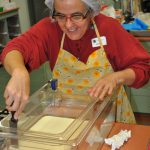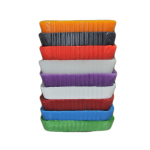Rennet is one of the most important ingredients in cheesemaking. However there are several practical considerations that the cheesemaker needs to be aware of that can affect how well the rennet will work when it is added to the milk to make cheese.
Background to forming a cheese curd
A key part of making cheese is forming a curd. A cheese curd can be formed by either the addition or production of acid in the milk (acid set cheese) or by the addition of rennet. The latter is the subject of this article and technically referred to as a paracaseinate curd but can also be referred to simply as rennet set curd. The vast majority of cheeses that you will make and eat will come from rennet set curds.
What is happening when the rennet forms a curd?
When rennet is added to the milk it needs to be stirred in very well, the milk is then left undisturbed for up to 60 minutes depending on the recipe. During this time the milk gradually turns from a liquid into a solid. During this coagulation process the rennet splits off the casein from the other proteins to allow the casein to form a fibrous structure referred to as a gel, a set or a sponge. This gel now contains all of the fat, water, casein, whey proteins, calcium, starter cultures and the rennet itself.
What are the Practical considerations for the cheesemaker
A cheesemaker requires the gel to be a certain strength before the gel can be cut and stirred. It is not the cheese will not have the required body and texture and will most likely be of inferior quality. But there are several factors that can determine how strong a gel is going to be. The following are several variable factors that you need to be aware of that can change how well a gel is formed after you add the rennet:
A. Volume of rennet added:Only add the required rennet according to the recipe and to form a firm set in the required amount of time. Adding additional rennet may achieve a firm set but the additional ezymic activity may produce weak and pasty bodies and off flavours in the cheese. The required amount of rennet should be accurately measured in a clean plastic syringe or small graduated measuring cylinder and stirred into the milk very well.
B. Temperature of the milk: Rennet acts best at 40°C ‑43°C, but will work satisfactorily but slower at 30‑32°C. Some recipes use lower temperatures for setting milk because it is the most suitable for starter growth and at this stage it is vital to ‘get the starters moving’.
C. Acidity of the milk: The action of rennet in milk is greatly accelerated by small increases in acidity. The ripening of milk after starter addition has the effect of speeding up rennet setting times.
D. Milk from sick cows, cows in late lactation and mastitis affected milk: The very slight increase in alkalinity in these milks is enough to impair rennet action. The additional albumin and globulin caused by mastitis infection also retards coagulation.
E. Soluble calcium available in the milk: Coagulation will not occur in the absence of soluble calcium. Milk may contain a shortage of this calcium and this will lead to a soft weak curd. The additional of calcium chloride to the milk may rectify this. If adding additional calcium do so at least one hour before the addition of the rennet or the effect of the additional calcium may be minimised.
F. Heating of milk: Excessive heating of milk precipitates the soluble calcium, therefore it is important not to pasteurise above recommended pasteurisation temperatures. Many commercially milks are pasteurised at slightly higher temperatures to increase their shelf life. If this is the case the additional of Calcium is important.
G. Age of milk: Milk that is several days old will not set as well as fresh milk. In addition the proteins will have been affected by the action of unwanted or nonstarter bacteria growing in the milk over this time.



